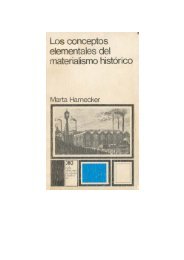Eric Hobsbawn – Historia del siglo XX - UHP
Eric Hobsbawn – Historia del siglo XX - UHP
Eric Hobsbawn – Historia del siglo XX - UHP
You also want an ePaper? Increase the reach of your titles
YUMPU automatically turns print PDFs into web optimized ePapers that Google loves.
OTRAS LECTURAS 595<br />
volúmenes y puestas al día, de algunas regiones y continentes <strong>del</strong> mundo, pero no (al menos<br />
en inglés), aunque parezca mentira, de Europa ni <strong>del</strong> mundo, excepto para la historia<br />
económica. La History of the World Economy in the Twentieth Century de Penguin, en cinco<br />
volúmenes, posee una calidad destacable: Gerd Hardach, The First World War 1914-1918;<br />
Derek Aldcroft, From Versailles to Wall Street, 1919-1929; Charles Kindleberger, The World<br />
in Depression 1929-1939; la soberbia obra de Alan Milward, War, Economy and Society,<br />
1939-45, y Herman van der Wee, Prosperity and Upheaval: The World Economy 1945-1980.<br />
[De todos ellos hay traducción castellana en Crítica, reunidos en la serie «<strong>Historia</strong> Económica<br />
Mundial <strong>del</strong> Siglo <strong>XX</strong>»: La primera guerra mundial, 1914-1918; De Versalles a Wall Street,<br />
1919-1929; La crisis económica, 1929-1939; La segunda guerra mundial, 1939-1945;<br />
Prosperidad y crisis. Reconstrucción, crecimiento y cambio, 1945-1980, 1985-1987. ]<br />
En cuanto a las obras regionales, los volúmenes relativos al <strong>siglo</strong> <strong>XX</strong> de Cambridge<br />
History of Africa (vols. 7-8), Cambridge History of China (vols. 10-13) y Cambridge History<br />
of Latin America, dirigida por Leslie Bethell (vols. 6-9; hay trad. cast. en preparación: <strong>Historia</strong><br />
de América Latina, Crítica, vols. 11 y ss. ), son las obras más actualizadas, tanto para<br />
consultas como para ser leídas de una vez. Por desgracia, la New Cambridge History of India<br />
no está demasiado a<strong>del</strong>antada por el momento.<br />
Marc Ferro, The Great War (1973), y Jay Winter, The Experience of World War 1 (1989),<br />
pueden servir de guía a los lectores para adentrarse en la primera guerra mundial; Peter<br />
Calvocoressi, Total War (ed. 1989), Gerhard L. Weinberg, A World at Arms: a Global History<br />
of World War 11 (1994, hay trad. cast. en Grijalbo, Barcelona, 1995), y el libro de Alan<br />
Milward sobre la segunda guerra mundial. Gabriel Kolko, Century of War: Politics, Conflict<br />
and Society since 1914 (1994), cubre ambas guerras y sus revolucionarias consecuencias. Para<br />
las revoluciones <strong>del</strong> mundo, John Dunn, Modern Revolutions (1989 2 ), y <strong>Eric</strong> Wolf, Peasant<br />
Wars of the Twentieth Century (1968), abarcan toda —o casi toda— la gama de las<br />
revoluciones, incluidas las <strong>del</strong> tercer mundo. Véase también William Rosenberg y Marilyn<br />
Young, Transforming Russia and China: Revolutionary Struggle in the Twentieth Century<br />
(1982). E. J. Hobsbawm, Revolutionaries (1973, hay trad, cast.: Revolucionarios, Ariel,<br />
Barcelona, 1979), especialmente los capítulos 1-8, es una introducción a la historia de los<br />
movimientos revolucionarios.<br />
La revolución rusa, con aluviones de monografías, no posee en cambio síntesis generales,<br />
como es el caso de la revolución francesa. Continúa reescribiéndose. León Trotsky, <strong>Historia</strong><br />
de la revolución rusa (1932), es el punto de vista desde la cumbre (marxista); W. H.<br />
Chamberlin, The Russian Revolution 1917-21 (reimpr. 1965, 2 vols. ), es el de un observador<br />
contemporáneo. Marc Ferro, The Russian Revolution of February 1917 (1972) y October 1917<br />
(1979) constituyen una buena introducción. Los numerosos volúmenes de la monumental<br />
History of Soviet Russia (1950-1978), de E. H. Carr, están más indicados para usarse como<br />
libros de referencia. Sólo llegan hasta 1929. Alec Nove, An Economic History of the USSR<br />
(1972) y The Economics of Feasible Socialism (1983) constituyen buenas introducciones a las<br />
apreciaciones <strong>del</strong> «socialismo realmente existente» (hay trad. cast. de ambos: <strong>Historia</strong><br />
económica de la Unión Soviética, Alianza, Madrid, 1973, y La economía <strong>del</strong> socialismo<br />
factible, Siglo <strong>XX</strong>I, Madrid, 1987). Basile Kerblay, Modern Soviet Society (1983), es lo más<br />
próximo a un estudio desapasionado de sus resultados en la URSS que podemos hallar en la<br />
actualidad. F. Fejtö ha escrito historias contemporáneas de las «democracias <strong>del</strong> pueblo». Para<br />
China, Stuart Schram, Mao Tse-tung (1967), y John K. Fairbank, The Great Chínese<br />
Revolution 1800-1985 (1986); véase también Jack Gray, op. cit.<br />
596 HISTORIA DEL SIGLO <strong>XX</strong><br />
La economía mundial está cubierta por la <strong>Historia</strong> de Penguin citada anteriormente, por P.<br />
Armstrong, A. Glyn y J. Harrison, Capitalism since 1945 (1991), y por S. Marglin y J. Schor, eds.,<br />
The Golden Age of Capitalism (1990). Para el período anterior a 1945, son indispensables las<br />
publicaciones de la Sociedad de Naciones, y para el período posterior a 1960, las <strong>del</strong> Banco<br />
Mundial, la OCDE y el FMI.<br />
Para la política de entreguerras y la crisis de las instituciones liberales, pueden sugerirse Charles<br />
S. Maier, Recasting Bourgeois Europe (1975), F. L. Carsten, The Rise of Fascism (1967), H. Rogger<br />
y E. Weber, eds., The European Right: a Historical Profile (1965), e Ian Kershaw, The Nazi<br />
Dictatorship: Problems and perspectives (1985). Para el espíritu <strong>del</strong> antifascismo, P. Stansky y W.<br />
Abrahams, Journey to the Frontier: Julian Bell and John Cornford (1966). Para el estallido de la<br />
guerra, Donald Cameron Watt, How War Came (1989). El mejor panorama general de la guerra fría<br />
hasta el momento es el de Martin Walker, The Cold War and the Making of the Modern World<br />
(1993), y la introducción más clara a sus últimas fases, F. Halliday, The Making of the Second Cold<br />
War (1986 ! ). Véase también J. L. Gaddis, The Long Peace: Inquiries into the History of the Cold<br />
War (1987). Para la remo<strong>del</strong>ación de Europa, Alan Milward, The Reconstruction of Western<br />
Europe 1945-51 (1984). Para el consenso político y el estado <strong>del</strong> bienestar, P. Flora y A. J.<br />
Heidenheimer, eds., Depelopment of Welfare States in America and Europe (1981), y D. W. Urwin,<br />
Western Europe since 1945: a Short Political History (ed. revisada, 1989). Véase también J.<br />
Goldthorpe, ed., Order and Conflict in Contemporary Capitalism (1984). Para los Estados Unidos,<br />
W. Leuchtenberg, A Troubled Feast: American Society since 1945 (1973).<br />
Para el final de los imperios, Rudolf von Albertini, Decolonization: the Administration and<br />
Future of Colonies, 1919-1960 (1961), y la excelente obra de R. F. Holland, European<br />
Decolonization 1918-1981 (1985). La mejor manera de encaminar a los lectores en la historia <strong>del</strong><br />
tercer mundo es mencionar un puñado de obras que de distintas maneras no tienen ninguna relación<br />
con él. Europe and the People without History (1983), de <strong>Eric</strong> Wolf, es una obra fundamental, si bien<br />
sólo se ocupa marginalmente de nuestro <strong>siglo</strong>. Lo mismo ocurre, de diferentes maneras, sobre el<br />
capitalismo y el comunismo, con Philip C. C. Huang, The Peasant Family and Rural Development in<br />
the Yangzi Delta, 1350-1988 (1990), sobre el que Robin Blackburn me ha llamado la atención. Puede<br />
compararse con la obra clásica de Clifford Geertz, Agrícultural Involution (1963), sobre Indonesia.<br />
Sobre la urbanización <strong>del</strong> tercer mundo, la cuarta parte <strong>del</strong> libro de Paul Bairoch, Cities and<br />
Economic Development (1988) es esencial. Sobre la política, Joel S. Migdal, Strong Societies and<br />
Weak States (1988) está repleto de ejemplos e ideas, algunos de ellos convincentes.<br />
Para las ciencias, Gerald Holton, ed., The Twentieth-Century Sciences (1972) constituye un<br />
punto de partida; para el desarrollo intelectual en general, George Lichtheim, Europe in the Twentieth<br />
Century (1972). Una buena introducción a las artes de vanguardia es la obra de John Willett, Art<br />
and Politics in the Weimar Period: The New Sobriety, 1917-1933 (1978).<br />
No existen hasta el momento aproximaciones históricas sobre las revoluciones culturales y<br />
sociales de la segunda parte <strong>del</strong> <strong>siglo</strong>, aunque el corpus de los comentarios y la documentación es<br />
vasto, y lo bastante accesible para que muchos de nosotros nos formemos nuestras propias<br />
opiniones (véase la Bibliografía). Los lectores no deben dejarse engañar por el tono de seguridad que<br />
se desprende de la bibliografía (incluidas mis propias observaciones) y confundir una opinión con la<br />
verdad establecida.





![Vandenberg - El secreto de los oráculos [pdf] - UHP](https://img.yumpu.com/13637083/1/184x260/vandenberg-el-secreto-de-los-oraculos-pdf-uhp.jpg?quality=85)